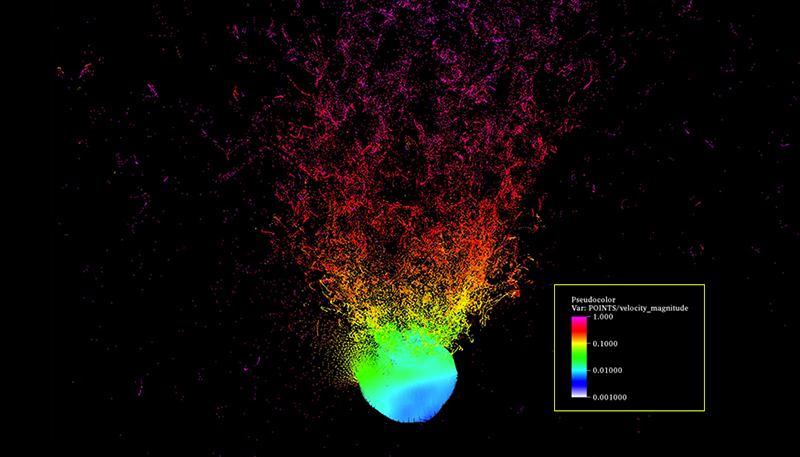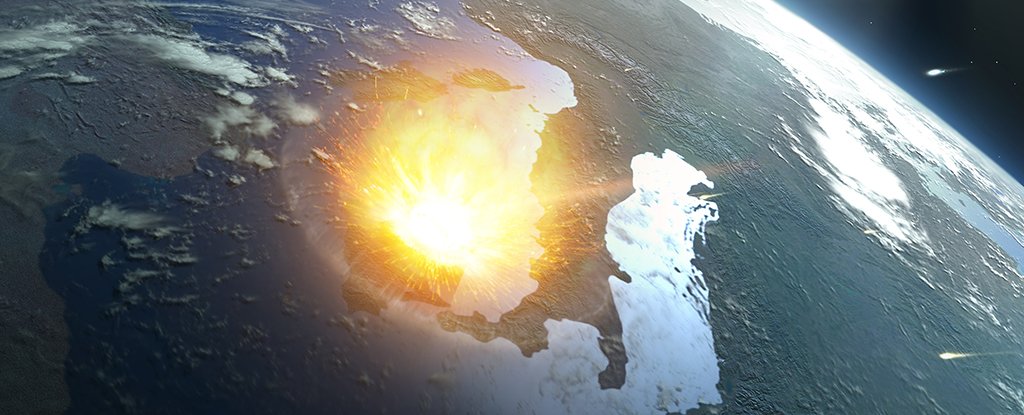Products You May Like
Reassuring news for those waiting to delay the apocalypse for as long as possible: A new study suggests that our last line of defense against an asteroid hitting Earth is an effective strategy after all.
That line of defence is what’s known as a late-time small-body disruption, which is exactly what it sounds like. It’s intended to blow relatively small asteroids to pieces when we’ve had very little warning time that they’re on a collision course with Earth.
These latest calculations suggest that such a defense is “very effective” in protecting against asteroid hits when the impact time is less than a year away – so we can all sleep a little easier in our beds as a result.
 The Spheral simulation that was used in the analysis. (Lawrence Livermore National Laboratory)
The Spheral simulation that was used in the analysis. (Lawrence Livermore National Laboratory)
“One of the challenges in assessing disruption is that you need to model all of the fragment orbits, which is generally far more complicated than modeling a simple deflection,” says physicist Patrick King from Johns Hopkins University in Maryland.
“Nevertheless, we need to try to tackle these challenges if we want to assess disruption as a possible strategy.”
The models that the researchers came up with looked at the impact of a 1-megaton-yield nuclear bomb hitting a 100-meter (328-foot) wide asteroid (about a fifth of the approximate size of Bennu).
Five different asteroid orbits were analyzed, with detonations performed anywhere from a week to six months before impact. For scenarios where we can hit the asteroid two months before its expected arrival, it’s possible to reduce the rain of destruction to just 0.1 percent of the original mass.
If the asteroid is a bigger pile of rock, there’s still a chance of reducing its impact mass to just 1 percent if we can hit it six months ahead of its due date.
That’s a great result, but this is still a last resort option that scientists don’t want to have to rely on: the preferred option is to deflect the asteroid away from Earth even earlier, which is a strategy that has been more fully researched and tested.
“We focused on studying ‘late’ disruptions, meaning that the impacting body is broken apart shortly before it impacts,” says King. “When you have plenty of time – typically decade-long timescales – it is generally preferred that kinetic impactors are used to deflect the impacting body.”
Figuring out where a multitude of fragments will end up once an asteroid has been blown apart is no easy task, and the team used a specialized piece of software called Spheral to figure out where these pieces of rock would be carried by gravity and other forces.
Get the calculations for blowing up an incoming object wrong, and a single asteroid impact could quickly turn into multiple impacts in several different places on Earth – the stakes couldn’t be much higher.
NASA and other agencies continue to invest in planetary defense systems, particularly when it comes to spotting potentially dangerous asteroids as early as possible. Longer timescales are crucial for maximizing our chances of pushing an asteroid off its course.
“Our group continues to refine our modeling approaches for nuclear deflection and disruption, including ongoing improvements to X-ray energy deposition modeling, which sets the initial blowoff and shock conditions for a nuclear disruption problem,” says physicist Megan Bruck Syal from the Lawrence Livermore National Laboratory (LLNL).
“This latest paper is an important step in demonstrating how our modern multiphysics tools can be used to simulate this problem over multiple relevant physics regimes and timescales.”
The research has been published in Acta Astronautica.
